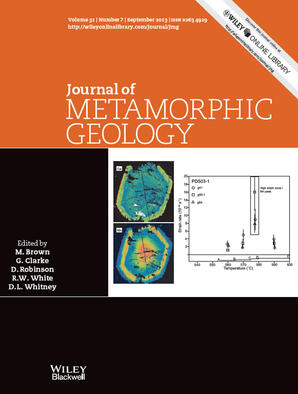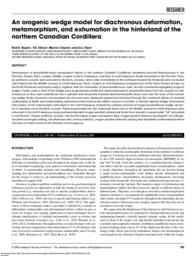Gibson, H.D.
Person Preferred Name
H.D. Gibson
Related Works
Content type
Digital Document
Abstract
Amphibolite facies metasedimentary schists within the Yukon-Tanana terrane in the northern Canadian Cordillera reveal a two-stage, polymetamorphic garnet growth history. In situ U-Th-Pb Sensitive High Resolution Ion Microprobe dating of monazite provide timing constraints for the late stages of garnet growth, deformation and subsequent decompression. Distinct textural and chemical growth zoning domains, separated by a large chemical discontinuity, reveal two stages of garnet growth characterized in part by: (i) a syn-kinematic, inclusion-rich stage-1 garnet core; and (ii) an inclusion-poor, stage-2 garnet rim that crystallized with syn- to post-kinematic staurolite and kyanite. Phase equilibria modelling of garnet molar and compositional isopleths suggest stage-1 garnet growth initiated at ~600 °C, 8 kbar along a clockwise P-T path. Growth of the compositionally distinct, grossular-rich, pyrope-poor inner portion of the stage-2 overgrowth is interpreted to have initiated at higher pressure and/or lower temperature than the stage-1 core along a separate P-T loop, culminating at peak P-T conditions of ~650-680 °C and 9 kbar. Stage-2 metamorphism and the waning development of a composite transposition foliation ( ST) are dated at c. 118 Ma from monazite aligned parallel to ST, and inclusions in syn- to post- ST staurolite and kyanite. Slightly younger ages ( c. 112 Ma) are obtained from Y-rich monazite that occurs within resorbed areas of both stage-1 and stage-2 garnet, together with retrograde staurolite and plagioclase. The younger ages obtained from these texturally and chemically distinct grains are interpreted, with the aid of phase equilibria calculations, to date the growth of monazite from the breakdown of garnet during decompression at c. 112 Ma. Evidence for continued near-isothermal decompression is provided by the presence of retrograde sillimanite, and cordierite after staurolite, which indicates decompression below ~4-5 kbar prior to cooling below ~550 °C. As most other parts of the Yukon-Tanana terrane were exhumed to upper crustal levels in the Early Jurassic, these data suggest this domain represents a tectonic window revealing a much younger, high-grade tectono-metamorphic core (infrastructure) within the northern Cordilleran orogen. This window may be akin to extensional core complexes identified in east-central Alaska and in the southeastern Canadian Cordillera. [ABSTRACT FROM AUTHOR]
Origin Information
Content type
Digital Document
Abstract
In situ sensitive high-resolution ion microprobe monazite geochronology and garnet isopleth thermobarometry reveal a previously unrecognized Middle Jurassic to earliest Cretaceous mid-crustal tectono-metamorphic event in the eastern part of the Yukon-Tanana terrane (Finlayson Lake district, southeast Yukon) in the northern Canadian Cordillera. Intersection of garnet end-member compositional isopleths applied to single-stage, growth-zoned garnet records progressive garnet growth from 550 °C and 6.1–6.6 kbar to 600 °C and 7.5 kbar. Monazite textures, chemical zoning, and in situ U-Pb ages record a single protracted episode of monazite growth from ca. 169 to 142 Ma coeval with the development of transposition fabrics and the late stages of garnet growth. This event post-dates widespread Early Jurassic exhumation of Yukon-Tanana terrane rocks west of the Tintina fault in west-central Yukon, which were previously ductily deformed and metamorphosed in the Permo-Triassic. The lack of evidence for Permo-Triassic ductile deformation and high-grade metamorphism within the Finlayson Lake district, and its position east of the Permian arc center and west of Permian blueschists and eclogites, suggests this eastern part of the terrane occupied the cool forearc at this time. These data indicate younger, more protracted mid-crustal orogenesis in the northern Cordillera than was previously recognized, with deformation and metamorphism migrating toward the foreland and downwards in the Middle Jurassic to Early Cretaceous, in part contemporaneous with and analogous to that in the southeastern Canadian Cordillera.
Origin Information
Content type
Digital Document
Abstract
Development of amphibolite-facies transposition fabrics in the northern Canadian Cordilleran hinterland occurred diachronously in the Permian–Triassic, Early Jurassic, Middle Jurassic to Early Cretaceous, and Early to mid-Cretaceous. Rocks tectonized in the Permian–Trias- sic and Early Jurassic were exhumed in the Early Jurassic, while rocks immediately to the northeast (toward the foreland) were not buried and heated until the Middle Jurassic to mid-Cretaceous. Early Jurassic to mid-Cretaceous emplacement of the Yukon-Tanana terrane on the North American continental margin, together with the imbrication of parautochthonous rocks, formed a foreland-propagating orogenic wedge. Cooler rocks in front of the wedge were progressively buried and metamorphosed to amphibolite facies from the Jurassic to mid- Cretaceous as they were underthrust into a spatially and temporally transient distributed ductile shear zone near the base of the overrid- ing wedge. Rocks previously incorporated into this zone were displaced upward and exhumed through the combined effects of renewed underplating at depth and compensating extensional and erosional denudation above to maintain a critically tapered wedge. Extensional exhumation of the metamorphic hinterland in the mid-Cretaceous marked the collapse and end of orogen-perpendicular wedge dynam- ics in operation since the Early Jurassic. Rocks incorporated into the midcrustal shear zone in the Middle Jurassic to mid-Cretaceous were exhumed in the mid-Cretaceous along southeast-directed (orogen-parallel) extensional faults from beneath a supracrustal “lid” tectonized in the Permian–Triassic and Early Jurassic. Like the Himalayan orogen and eastern Alps, orogen-parallel extension developed in an orthogo- nal plate-convergent setting, simultaneous with, and bounded by, orogen-parallel strike-slip faulting that facilitated northwestward lateral extrusion of rocks normal to the direction of convergence.
Origin Information



